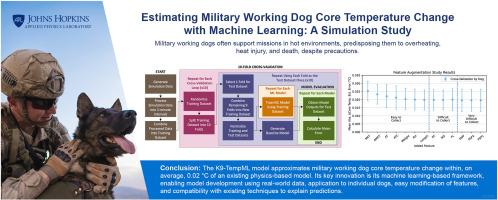Estimating military working dog core temperature change with machine learning: A simulation study
IF 2.9
2区 生物学
Q2 BIOLOGY
引用次数: 0
Abstract
Military working dogs play a critical role in supporting the United States Military across various missions. Many missions occur in hot environments and predispose military working dogs to hyperthermia, a leading cause of their death. A previous effort created a physics-based model to estimate military working dog core temperature change based on dog attributes, metabolic activity, and environmental conditions. We hypothesize that a machine learning model that builds on the physics-based model may offer additional and complementary benefits. This includes the ability to infer relationships from real-world data, easy modification of features, and compatibility with existing techniques to explain predictions. These benefits would enhance model usability and applicability, especially for scenarios where dogs’ core temperature change patterns may be atypical. As a first step towards a machine learning-based modeling framework, we approximated the physics-based model with three machine learning models, showing feasibility of applying machine learning to this type of data. Of these models, the random forest model, which we dub the “K9-TempML” model, provides the closest core temperature change estimates to the physics-based model and offers well-established methods for feature analyses. We performed feature analysis and augmentation studies on this model to determine the impact of each feature on core temperature change estimates, demonstrating that removing features that are difficult to collect could retain model accuracy but improve usability. Future work includes training a machine learning-based model using real-world data, applying the model to individual military working dogs, and integrating the model into a real-time core temperature change estimation tool and pre-deployment planning aid.

用机器学习估计军事工作犬核心温度变化:一项模拟研究
军事工作犬在支持美国军队完成各种任务方面发挥着关键作用。许多任务都是在炎热的环境中进行的,这使军事工作犬容易患高热症,这是导致它们死亡的主要原因。之前的一项研究创建了一个基于物理的模型,根据狗的属性、代谢活动和环境条件来估计军事工作犬的核心温度变化。我们假设,基于物理模型的机器学习模型可能会提供额外的和互补的好处。这包括从真实世界的数据中推断关系的能力,易于修改的特性,以及与现有技术的兼容性来解释预测。这些好处将提高模型的可用性和适用性,特别是在狗的核心温度变化模式可能是非典型的情况下。作为迈向基于机器学习的建模框架的第一步,我们用三个机器学习模型近似了基于物理的模型,展示了将机器学习应用于这类数据的可行性。在这些模型中,随机森林模型,我们称之为“K9-TempML”模型,提供了最接近物理模型的核心温度变化估计,并为特征分析提供了完善的方法。我们对该模型进行了特征分析和增强研究,以确定每个特征对核心温度变化估计的影响,证明去除难以收集的特征可以保持模型的准确性,但提高可用性。未来的工作包括使用真实世界数据训练基于机器学习的模型,将该模型应用于单个军事工作犬,并将该模型集成到实时核心温度变化估计工具和部署前规划辅助中。
本文章由计算机程序翻译,如有差异,请以英文原文为准。
求助全文
约1分钟内获得全文
求助全文
来源期刊

Journal of thermal biology
生物-动物学
CiteScore
5.30
自引率
7.40%
发文量
196
审稿时长
14.5 weeks
期刊介绍:
The Journal of Thermal Biology publishes articles that advance our knowledge on the ways and mechanisms through which temperature affects man and animals. This includes studies of their responses to these effects and on the ecological consequences. Directly relevant to this theme are:
• The mechanisms of thermal limitation, heat and cold injury, and the resistance of organisms to extremes of temperature
• The mechanisms involved in acclimation, acclimatization and evolutionary adaptation to temperature
• Mechanisms underlying the patterns of hibernation, torpor, dormancy, aestivation and diapause
• Effects of temperature on reproduction and development, growth, ageing and life-span
• Studies on modelling heat transfer between organisms and their environment
• The contributions of temperature to effects of climate change on animal species and man
• Studies of conservation biology and physiology related to temperature
• Behavioural and physiological regulation of body temperature including its pathophysiology and fever
• Medical applications of hypo- and hyperthermia
Article types:
• Original articles
• Review articles
 求助内容:
求助内容: 应助结果提醒方式:
应助结果提醒方式:


